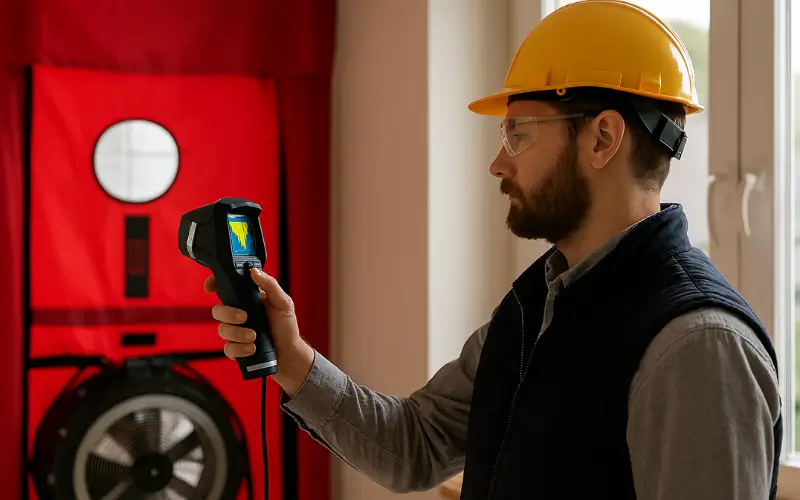Why Energy Waste in Garment Factories Deserves Urgent Attention
The global garment industry is one of the most resource-intensive sectors in modern manufacturing — and energy is a major component of that resource demand. From dyeing machines humming nonstop to HVAC systems running around the clock, garment factories consume massive amounts of electricity, gas, and steam daily. Yet, many of these facilities operate with outdated systems, inefficient practices, and minimal oversight — resulting in significant energy waste.
The problem isn’t just environmental — it’s financial. Unchecked energy waste in garments factories can lead to skyrocketing utility bills, reduced equipment lifespan, and missed opportunities for cost savings. And as global buyers increasingly demand sustainability across supply chains, ignoring energy inefficiencies is no longer an option.
Energy Wasting Habits in Garments Factories
This article will explore the Top 5 Energy-Wasting Habits in Garment Factories — and, more importantly, provide actionable solutions to help you reduce waste, improve efficiency, and enhance your factory’s bottom line.
Whether you’re a factory manager, sustainability officer, or business owner in the garment sector, these insights will help you take control of your energy use and position your operation for long-term success.
Let’s dive in.
1. Inefficient Lighting Systems: A Silent Energy Drainer
Lighting may seem like a minor operational detail in a garment factory, but it’s often one of the biggest contributors to energy waste. Many factories continue to rely on outdated, energy-intensive lighting systems that silently inflate utility bills while offering subpar illumination.
Overuse of Traditional Lighting
A large number of garment factories still operate with incandescent bulbs, halogen lamps, or older fluorescent tubes, all of which consume significantly more power than modern alternatives. These systems not only draw more energy per unit of light output, but they also generate excess heat, increasing the cooling load on HVAC systems — a double energy hit.
Example:
An incandescent bulb typically consumes 60 watts, whereas an LED bulb with the same brightness uses only 10 watts. If a factory uses 1,000 such bulbs, the energy savings can be massive.
Lack of Natural Light Utilization
Many factory layouts are poorly designed when it comes to maximizing natural light. Obstructed windows, tinted glass, and heavy internal partitioning often mean that even during daylight hours, artificial lighting is used excessively.
Impacts:
- Increased reliance on artificial lighting.
- Higher energy bills during peak sunlight hours.
- Missed opportunity for daylight-integrated workspaces that enhance worker well-being.
Solutions
1. Switch to LED Lighting Systems: LEDs are up to 80% more efficient than traditional bulbs. They also last longer, reducing maintenance costs and interruptions to production.
2. Install Motion Sensors and Timers: These devices automatically switch off lights in unoccupied areas — such as storage rooms, restrooms, or seldom-used hallways — cutting unnecessary usage.
3. Optimize Natural Light Design:
- Add skylights, transparent roofing panels, or larger windows in common work areas.
- Use reflective surfaces and light-colored walls to spread daylight more effectively.
- Schedule maintenance to clean windows and remove obstructions that block sunlight.
4. Conduct a Lighting Audit
Evaluate your current lighting load and identify areas where upgrades can have the highest ROI.
2. Outdated Machinery and Equipment: The Hidden Energy Hog
In many garment factories, machines are the beating heart of production — but outdated or poorly maintained equipment often consumes far more energy than necessary. While they may still “get the job done,” the hidden cost in electricity and inefficiency is staggering.
Energy Drain from Legacy Machines
Many older machines were manufactured during a time when energy efficiency wasn’t a priority. These machines:
- Consume more electricity per cycle or unit produced.
- Often lack auto-shutdown features, continuing to draw power during idle times.
- Generate excess heat, contributing to higher cooling loads and indoor discomfort.
Examples of high-energy equipment:
- Industrial sewing machines without energy-saving motors.
- Dyeing machines with outdated heating systems.
- Vacuum finishing or pressing equipment using old steam generators.
In fact, studies show that outdated machines can consume up to 30% more power than modern equivalents for the same output.
Case Studies: Energy Savings Through Upgrades
Bangladesh Case Example:
A knitwear factory in Dhaka replaced its older motor-driven knitting machines with energy-efficient servo motor models. The result?
- 25% reduction in electricity usage.
- Lower maintenance costs.
- Enhanced production speed and consistency.
India Case Example:
A factory introduced variable frequency drives (VFDs) to control motor speed in their exhaust and air systems. The upgrade paid for itself in just under 18 months through energy savings alone.
Solutions
1. Invest in Energy-Efficient Machinery
- Look for machines certified with energy-saving labels or compliant with ISO 50001 standards.
- Replace clutch motor sewing machines with servo motor ones — they consume 60–80% less energy.
2. Retrofit Instead of Replace
- Attach inverter drives to older motors to regulate speed based on load.
- Install thermal insulation around heating components to prevent unnecessary heat loss.
3. Implement Preventive Maintenance
- Schedule regular check-ups for machine lubrication, alignment, and calibration.
- Clean dust filters, fans, and vents to prevent overheating and inefficiency.
4. Train Machine Operators
- Train workers to switch off machines when not in use.
- Encourage energy-conscious habits like grouping similar operations to reduce idle time.
3. Poor Insulation and Heat Loss: Leaking Energy Around the Clock
Energy efficiency in garment factories isn’t only about electricity — thermal energy plays a huge role too. Unfortunately, many factories hemorrhage heat due to poor insulation and outdated infrastructure. Whether it’s steam used in pressing operations or heated water for dyeing, a significant amount of thermal energy is wasted simply because it’s not properly contained.
Uninsulated Steam Pipes and Boilers
Steam is commonly used in garment processing — for ironing, finishing, and dyeing. But in many factories:
- Steam pipes are left uninsulated or have deteriorated insulation.
- Steam leaks go unnoticed for weeks or months.
- Boilers run continuously, even during low-demand hours, losing heat to the surrounding environment.
Consequences:
- Increased fuel consumption (diesel, gas, or coal).
- Longer production cycles due to unstable heat levels.
- High operational costs and safety hazards.
Data Point:
Uninsulated steam pipes can result in energy losses of up to 20–30%, especially in humid climates like Bangladesh or Southeast Asia.
Building Insulation Issues
Beyond process heat, many factories lose energy through the building envelope — the walls, roofs, and windows that make up the structure.
Common causes of thermal inefficiency:
- Thin or single-pane windows with no heat-reflective coating.
- Metal sheet roofing with no insulation material.
- Gaps in walls or ceilings causing drafts.
- Non-insulated loading docks and storage areas.
This leads to:
- Higher HVAC load in both summer and winter.
- Unstable indoor working conditions.
- Strain on cooling or heating systems, especially during peak production seasons.
Solutions
1. Insulate Steam Pipes and Boilers
- Wrap pipes, joints, and valves with high-temperature insulation (e.g., fiberglass, calcium silicate).
- Regularly inspect for insulation wear and tear.
- Use condensate recovery systems to reclaim energy from used steam.
2. Improve Building Envelope Insulation
- Install roof insulation panels under metal sheets or concrete slabs.
- Use double-glazed or reflective glass in office and production areas.
- Seal gaps in doors, windows, and loading zones using weather stripping and door sweeps.
3. Smart Boiler Controls
- Equip boilers with automatic temperature control systems.
- Shut down boilers during idle periods (e.g., night shifts or weekends).
- Monitor and track fuel-to-steam efficiency regularly.
4. Conduct a Thermal Imaging Survey
- Use infrared cameras to detect invisible heat leaks.
- Prioritize insulation upgrades in high-loss areas first for maximum ROI.
4. Inefficient HVAC Systems: Cooling Costs That Burn Your Budget
In garment manufacturing, ventilation and temperature control are essential for both productivity and worker well-being — especially in regions with high humidity or heat. However, inefficient HVAC (Heating, Ventilation, and Air Conditioning) systems often run around the clock without proper controls, wasting enormous amounts of energy in the process.
Overcooling or Overheating Work Areas
Many factories set thermostats too low or high, regardless of actual need. Production spaces are often cooled more than necessary, or heat is applied inappropriately during shoulder seasons (spring/fall), leading to:
- Overworked compressors and blowers.
- Higher wear and tear on HVAC systems.
- Significant increases in electricity consumption.
Problem: Most factories lack zoned climate control, meaning large areas are cooled or heated uniformly — even if only one section is occupied.
Poor Maintenance Practices
Just like any machine, HVAC systems need routine care. But in many garment factories:
- Filters are clogged, reducing airflow and increasing load.
- Coils are dirty, forcing systems to work harder to achieve the same temperature.
- Leaks in ductwork allow cooled or heated air to escape before reaching target areas.
All of these issues lead to:
- Higher electricity bills.
- Shorter equipment lifespan.
- Discomfort for workers, which can impact productivity and morale.
Inefficient Ventilation and Air Exchange
Many garment processes (like dyeing and finishing) produce heat, moisture, and airborne particles that must be removed for safety and comfort. However:
- Outdated or underpowered exhaust fans fail to remove indoor heat effectively.
- Inlet systems bring in untreated hot air, forcing cooling systems to work harder.
- Lack of energy recovery ventilation (ERV) results in cooled air being wasted.
Solutions
1. Install Smart Thermostats and Zoned HVAC Systems
- Divide factory floors into zones and control them independently.
- Use programmable thermostats to adjust temperature automatically based on occupancy or shift hours.
2. Implement a Preventive Maintenance Program
- Clean filters monthly and replace when needed.
- Inspect ducts for leaks and seal them with proper materials.
- Clean coils and blower fans regularly for optimal airflow.
3. Upgrade to Energy-Efficient HVAC Units
- Choose systems with high SEER ratings (Seasonal Energy Efficiency Ratio).
- Install inverter-driven air conditioners, which adjust output based on real-time load.
- Opt for heat pumps or VRF systems for better efficiency in multi-zone facilities.
4. Use Natural Ventilation and Heat Recovery
- Integrate roof vents, louver systems, or ventilation stacks to circulate fresh air naturally.
- Install Energy Recovery Ventilators (ERVs) to reuse cooled air from exhaust systems.
5. Lack of Energy Monitoring and Awareness: You Can’t Fix What You Don’t Track
Despite increasing pressure from brands and regulators to improve sustainability, many garment factories still lack a basic system for tracking energy usage. Without proper monitoring, it’s nearly impossible to identify energy-wasting habits or measure the impact of improvements. Even worse, employees often aren’t aware that their daily actions contribute to energy waste.
No Real-Time Energy Data or Tracking Tools
Most factories either:
- Rely only on monthly utility bills, which offer no insight into which machines or processes are consuming the most energy.
- Don’t segment energy usage by department, meaning there’s no way to attribute overconsumption to specific areas like dyeing, finishing, or lighting.
- Lack automated monitoring tools, so inefficiencies go unnoticed until costs spiral out of control.
Problem: If you don’t know where your energy is going, you can’t reduce it — and you’re likely missing out on easy savings.
Lack of Staff Awareness and Engagement
Many factory workers and even mid-level managers are unaware of how energy usage ties into their daily tasks. For example:
- Operators leave machines running idle between shifts.
- Maintenance teams don’t prioritize energy-efficient settings or repairs.
- Office staff leave lights, fans, or equipment running overnight.
Solutions
1. Install Energy Monitoring Systems
- Use smart energy meters and sub-meters to track consumption by zone or equipment.
- Monitor key variables like kWh usage, steam flow, compressor runtime, etc.
- Use dashboards or software platforms (e.g., Eniscope, Energyly, Wattics) to visualize patterns.
2. Conduct an Energy Audit
- Hire a certified auditor to identify areas of energy loss.
- Benchmark your facility’s energy intensity (e.g., kWh per piece produced).
- Create an energy baseline and set measurable goals.
3. Train and Engage Employees
- Launch awareness campaigns on energy-saving behavior (turning off unused machines, proper shutdown procedures).
- Set up incentive programs that reward departments for hitting energy reduction targets.
- Appoint Energy Champions within teams to lead initiatives and collect feedback.
4. Implement Energy Policies and SOPs
- Develop a formal Energy Management Policy.
- Create standard operating procedures (SOPs) for energy-efficient equipment use.
- Encourage leadership to model energy-conscious behavior.
Conclusion: It’s Time to Sew Up the Energy Leaks
Energy waste in garment factories isn’t always loud or obvious — it often hides in plain sight, quietly increasing operational costs and environmental impact. From outdated lighting to inefficient HVAC systems and unmonitored consumption, every small inefficiency adds up.
The good news? Each of these problems has a practical solution.
By tackling the Top 5 Energy Wasting Habits — inefficient lighting, outdated machinery, poor insulation, suboptimal HVAC systems, and a lack of monitoring — factories can:
- Slash energy costs by 20–40%.
- Improve worker comfort and productivity.
- Boost sustainability and brand reputation.
- Strengthen compliance with global buyer standards.
These aren’t just operational fixes — they’re strategic moves toward a leaner, greener, and more competitive garment industry.
Call to Action: Take the First Step Today
Whether you’re a factory owner, sustainability manager, or part of a sourcing team, the time to act is now.
- Start by conducting a basic energy audit.
- Engage your team in identifying quick wins.
- Set realistic targets for improvement — and track your progress.
- Consider reinvesting energy savings into long-term upgrades.
By prioritizing energy efficiency, you’re not just cutting costs — you’re future-proofing your operations in a world that’s moving rapidly toward low-impact manufacturing.
Frequently Asked Questions (FAQs)
1. Why is energy efficiency important in garment factories?
Energy efficiency reduces operational costs, lowers carbon emissions, and aligns with international sustainability standards — which are increasingly demanded by global brands.
2. How can I measure energy waste in my factory?
Start with an energy audit and install sub-meters on major equipment. Smart energy monitoring tools can provide real-time insights into where and how energy is being used.
3. What is the most common source of energy waste in apparel production?
Outdated lighting systems and old machinery are often the biggest culprits, especially when they run continuously or during non-production hours.
4. Are energy-efficient upgrades expensive?
Some investments like LED lighting or insulation pay for themselves within months. Many solutions also qualify for subsidies, green loans, or carbon credit incentives.
5. How can staff contribute to saving energy?
Through training, awareness, and simple behavioral changes — such as turning off idle machines or reporting leaks — staff can play a vital role in reducing energy waste.
Written by: Israt Jahan
Junior Energy Analyst




